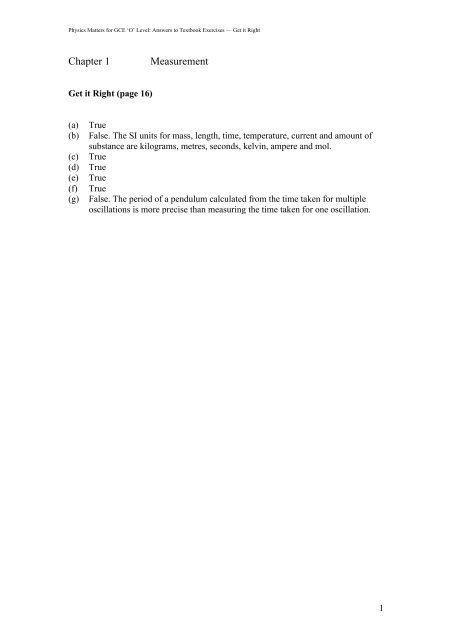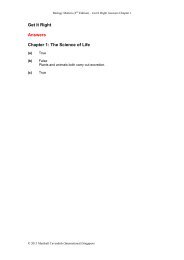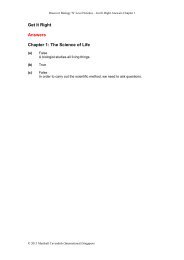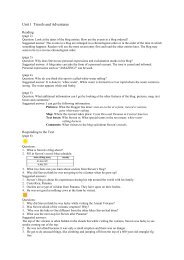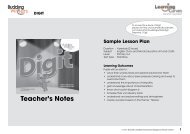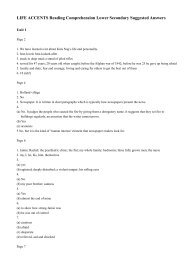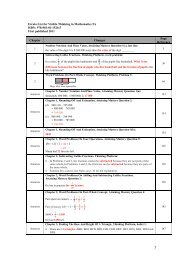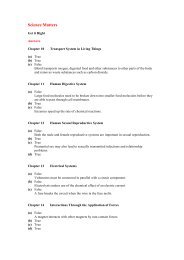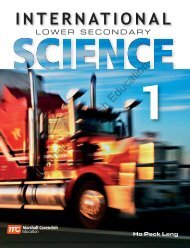Chapter 1 Measurement - Marshall Cavendish
Chapter 1 Measurement - Marshall Cavendish
Chapter 1 Measurement - Marshall Cavendish
You also want an ePaper? Increase the reach of your titles
YUMPU automatically turns print PDFs into web optimized ePapers that Google loves.
Physics Matters for GCE ‘O’ Level: Answers to Textbook Exercises — Get it Right<strong>Chapter</strong> 2KinematicsGet it Right (page 46)(a)(b)(c)(d)(e)(f)False. Velocity is a vector, and hence has magnitude and direction.TrueTrueFalse. The area under a velocity-time graph of an object gives its displacement.False. The velocity-time graph of a free-falling object is a straight line with a constantgradient.True2
Physics Matters for GCE ‘O’ Level: Answers to Textbook Exercises — Get it Right<strong>Chapter</strong> 3ForcesGet it Right (page 67)(a) False. Forces acting on the object are balanced.(b) True(c) False. To find the resultant or net effect of the action of two forces, we find theresultant force of the individual forces.(d) False. Newton’s 2 nd law states that the acceleration is produced by the net forcenot the mass and acceleration.(e) True(f) False. The law will ensure equilibrium when there are two forces – action andreaction pair only.(g) True3
Physics Matters for GCE ‘O’ Level: Answers to Textbook Exercises — Get it Right<strong>Chapter</strong> 4Mass, Weight and DensityGet it Right (page 80)(a)(b)(c)(d)(e)(f)(g)TrueTrueFalse. The gravitational force acts on all masses on Earth at a time.TrueFalse. Mass is a scalar quantity, whereas weight is a vector quantity.TrueFalse. If a block of metal is broken in two equal parts, the density of each partis the same as the original metal block as the substance of the two parts is thesame.4
Physics Matters for GCE ‘O’ Level: Answers to Textbook Exercises — Get it Right<strong>Chapter</strong> 6Energy, Work and PowerGet it Right (page 121)(a) False. The pendulum gains kinetic energy and retains potential energy so thatenergy is conserved.(b) True(c) False. When the speed of the bus is increased twofold, the kinetic energy of the busincreases by fourfold. (This can be deduced using the formula: E k = 1 2 mv2 .)(d) True(e) False. Work done = force × distance moved in the direction of the applied force.Since we do not know the distance moved in the direction of the force, we cannotcalculate the work done.(f) False. Power is the rate of work done or the rate of energy conversion.6
Physics Matters for GCE ‘O’ Level: Answers to Textbook Exercises — Get it Right<strong>Chapter</strong> 7PressureGet it Right (page 140)(a) False. Pressure is the defined as the force acting over an area.(b) False. According to the equation p = hρg, the pressure of a liquid increases withboth the depth and density of the liquid.(c) False. In a hydraulic press, the pressure of the liquid on both pistons is equal. Theforce acting on the larger piston is greater in magnitude than the force acting onthe smaller piston (assuming there is no friction).(d) True(e) True7
Physics Matters for GCE ‘O’ Level: Answers to Textbook Exercises — Get it Right<strong>Chapter</strong> 8TemperatureGet it Right (page 151)(a)(b)(c)(d)TrueTrueFalse. The two steps are to determine the fixed points and dividing the length betweenthe points into equal intervals.True8
Physics Matters for GCE ‘O’ Level: Answers to Textbook Exercises — Get it Right<strong>Chapter</strong> 9Kinetic Model of MatterGet it Right (page 165)(a) True(b) False. Smoke particles move randomly because air molecules are constantlybombarding them.(c) True(d) True(e) (i) True(ii) True(iii) False. The pressure of a fixed mass of gas at constant temperature is inverselyproportional to its volume.(f) True9
Physics Matters for GCE ‘O’ Level: Answers to Textbook Exercises — Get it Right<strong>Chapter</strong> 10 Transfer of Thermal EnergyGet it Right (page 182)(a)(b)(c)(d)(e)False. Energy is transferred from a region of higher temperature to a region of lowertemperature.TrueTrueFalse. Radiation does not require a medium for transfer.True10
Physics Matters for GCE ‘O’ Level: Answers to Textbook Exercises — Get it Right<strong>Chapter</strong> 11Thermal Properties of MatterGet it Right (page 207)(a)(b)(c)(d)(e)(f)(g)(h)(i)(j)TrueTrueFalse. Specific heat capacity is the amount of heat required to raise the temperature ofunit mass of a substance by 1 K or 1 o C.TrueFalse. Temperature remains constant during melting, solidification, boiling andcondensation.TrueFalse. Specific latent heat is the heat needed to change the state of unit mass of asubstance.Truelatent heat of substanceFalse. Specific latent heat of a substance =massFalse. Evaporation does not require an external source of heat.11
Physics Matters for GCE ‘O’ Level: Answers to Textbook Exercises — Get it Right<strong>Chapter</strong> 12LightGet it Right (page 249)(a) True(b) False. The angle of reflection is the angle between the reflected light ray and thenormal at the point of incidence.(c) True(d) False. Refraction does not occur if the incident ray travels along the normal fromone medium to another, i.e. if the angle of incidence in 0 o .(e) True(f) False. Light bends away from the normal when it travels from glass (opticallydenser medium) to air (optically less dense medium).ORLight bends towards the normal when it travels from air (optically less densemedium) to glass (optically denser medium).(g) True(h) False. The critical angle is the angle of incidence in an optically denser medium forwhich the angle of refraction in the optically less dense medium is 90°.(i) True(j) False. The focal length of a thin converging lens is the distance between its opticalcentre and its focal point (at the principal axis). Principal focus is just another namefor that focal point.(k) True12
Physics Matters for GCE ‘O’ Level: Answers to Textbook Exercises — Get it Right<strong>Chapter</strong> 14Electromagnetic WavesGet it Right (page 282)(a) True(b) False. There are transverse waves such as water waves that need a medium topropagate.(c) False. EM waves travel at the speed of light in vacuum. Their speeds are lower inother media.(d) True14
Physics Matters for GCE ‘O’ Level: Answers to Textbook Exercises — Get it Right<strong>Chapter</strong> 15SoundGet it Right (page 302)(a) True(b) False. Sound waves are longitudinal waves that comprise a series of rarefactions andcompressions.(c) True(d) False. The speed of sound depends on the medium it travels through. Sound has thehighest speed in solids and the lowest speed in gases.(e) False. An echo is formed when a sound is reflected off a hard, flat surface.(f) False. Ultrasound is sound with frequencies above 20 kHz.(g) TrueNote: A short period is equivalent to a high frequency, as f = 1 T .15
Physics Matters for GCE ‘O’ Level: Answers to Textbook Exercises — Get it Right<strong>Chapter</strong> 16Static ElectricityGet it Right (page 319)(a) False. There are two types of electric charges: negative charges and positive charges.(b) False. An electrically neutral object contains an equal number of negative and positivecharges.(c) False. Negative charges (electrons) are transferred from the glass rod to the piece ofsilk when these two objects are rubbed together.(d) True(e) False. An electron has 1.6 × 10 –19 C of charge.(f) False. One can charge conductors through induction because conductors contain freeelectrons.(g) False. Conductors can be discharged by earthing.(h) True(i) False. Electric field lines always point away from a positive charge.(j) True(k) True(l) False. In spray painting a car, the paint droplets are given like charges so that theyspread uniformly on the car body.16
Physics Matters for GCE ‘O’ Level: Answers to Textbook Exercises — Get it Right<strong>Chapter</strong> 17Current ElectricityGet it Right (page 338)(a) True(b) True(c) False. The e.m.f. and p.d. are both measured in volts. However, while e.m.f. is definedas the work done to drive a unit charge around a complete circuit, p.d. is defined as thework done to drive a unit charge between two points.(d) False. The e.m.f. is the work done by an electrical source to drive a unit charge arounda complete circuit.(e) True(f) True(g) False. The resistance of metallic conductors remains constant under steady physicalconditions. This is in accordance with Ohm’s Law.(h) True(i) False. Heating a metallic conductor causes the resistance of the conductor to increase.(j) True(k) False. A thicker wire has a lower resistance than a thinner wire of equal length andidentical material.17
Physics Matters for GCE ‘O’ Level: Answers to Textbook Exercises — Get it Right<strong>Chapter</strong> 18D.C. CircuitsGet it Right (page 359)(a)(b)(c)(d)(e)(f)(g)(h)False. Current is the same throughout a series circuit.TrueFalse. The current from the electrical source of a parallel circuit is equal to the sum ofthe currents in each parallel branch.False. In a parallel circuit, the p.d. across the whole circuit is equal to the p.d. acrosseach circuit component.TrueTrueTrueFalse. The resistance of a thermistor decreases as its temperature increases while theresistance of an LDR decreases as the brightness increases.18
Physics Matters for GCE ‘O’ Level: Answers to Textbook Exercises — Get it Right<strong>Chapter</strong> 19Practical ElectricityGet it Right (page 381)(a)(b)(c)(d)(e)(f)(g)(h)(i)TrueFalse. Energy consumed by an appliance is given by the product of its power ratingand time.False. The unit for power is kW while the unit for energy is kWh.False. Nuclear energy is from a non-renewable energy source.False. Overheating results if thin wires are used as they generate more heat than thickwires.False. The fuse chosen should have a rating that is slightly higher than the operatingcurrent of the appliance as it is designed to melt only when the operating current isexceeded.TrueFalse. The earth wire is yellow green in colour.True19
Physics Matters for GCE ‘O’ Level: Answers to Textbook Exercises — Get it Right<strong>Chapter</strong> 20MagnetismGet it Right (page 400)(a)(b)(c)(d)(e)(f)TrueFalse. Like poles repel and unlike poles attract.False. Only iron, nickel, cobalt and steel can be induced to become magnets.TrueFalse. Magnetic field lines point away from the North pole of a magnet and into theSouth poleTrue20
Physics Matters for GCE ‘O’ Level: Answers to Textbook Exercises — Get it Right<strong>Chapter</strong> 21ElectromagnetismGet it Right (page 421)(a)(b)(c)(d)(e)(f)(g)(h)(i)(j)(k)(l)False. The magnetic field lines around a current-carrying straight wire are concentriccircles, while the magnetic field lines around a current-carrying solenoid resemblethose of a bar magnet.TrueFalse. A circle with a dot in its centre represents current flowing towards you while acircle with a cross in its centre represents current flowing away from you.False. In a circuit breaker, an electromagnet magnet (temporary magnet) is used tobreak the circuit when there is current overflow.TrueFalse. We use Fleming’s left-hand rule to deduce the relative directions of force, fieldand current.False. Parallel conductors repel and attract when the currents in them are in opposingdirections and in the same direction respectively.False. The direction of the force on a beam of charged particles in a magnetic field isdependent on the type of charge the particles carry.TrueTrueFalse. The commutator reverses the direction of the current every half a revolution.False. The turning effect of the current-carrying coil in a d.c. motor can be increasedby increasing the number of turns on the coil, the size of the e.m.f and the presence ofa soft iron core in the coil.21
Physics Matters for GCE ‘O’ Level: Answers to Textbook Exercises — Get it Right<strong>Chapter</strong> 22Electromagnetic InductionGet it Right (page 446)(a)(b)(c)(d)(e)(f)(g)(h)(i)(j)False. A conductor is at rest in a rotating magnetic field. An e.m.f. will be induced inthis conductor as the magnetic flux linking the conductor is changing.TrueTrueTrueTrueTrueFalse. If the primary coil of an ideal transformer has the same number of turns as thesecondary coil, the e.m.f. will induced in the secondary coil is equal to the e.m.fsupplied to the primary coil.False. Electricity is transmitted at high voltage so that the power loss (P = I 2 R) isreduced.TrueFalse. On the c.r.o. screen, the vertical axis represents the voltage applied across theY-plates.22


